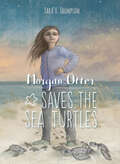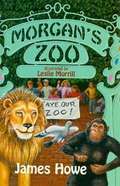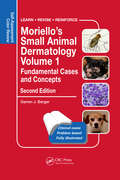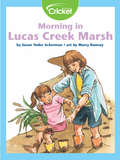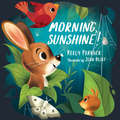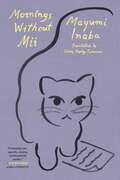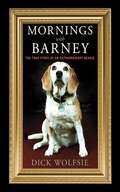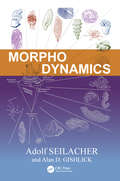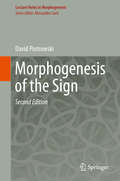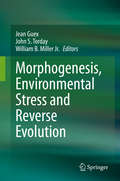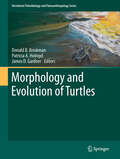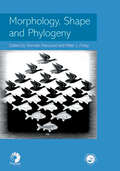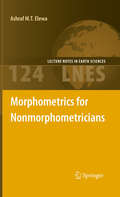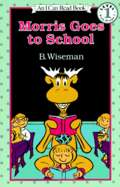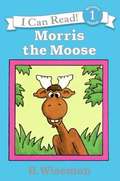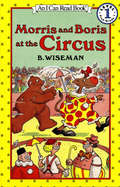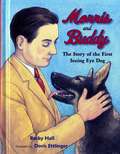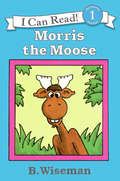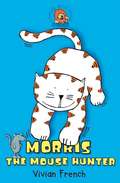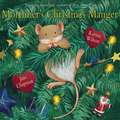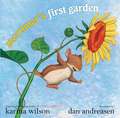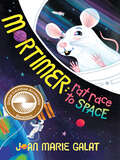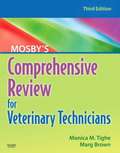- Table View
- List View
Morgan Horses
by Peggy Jett PittengerA history of the Morgan horse, covering the development of the breed, the breeding of Morgans by the U.S. Government for military use, and famous Morgan horses and Morgan breeders past and present. The author discusses the changes over the years in Morgan lines and uses, and includes many pictures and advertisements of famous Morgans from days past.
Morgan Otter Saves the Sea Turtles: Sea Turtle Superhero
by Tara V. Thompson Candace AndersenEight-year-old Morgan Otter moves from her home in the hot Arizona desert to damp, green Georgia when her father gets a new job. She attends a day camp at the Nature Center where she meets new friends and learns about the animals of the Lowcountry, including endangered sea turtles. As Morgan learns about the sea turtles, she vows to become a sea turtle superhero with her new friend, Claire. The dynamic duo help protect baby sea turtles at the beach and make sure they make it to the ocean unharmed.
Morgan's Zoo
by James HoweWhen the Chelsea Park Zoo is about to close, Morgan, the animal keeper, receives help from the animals themselves.
Moriello's Small Animal Dermatology Volume 1, Fundamental Cases and Concepts: Self-Assessment Color Review, Second Edition (Veterinary Self-Assessment Color Review Series)
by Darren BergerKaren Moriello's seminal book has been completely updated in an effort to create a true two-volume set highlighting fundamental and advanced concepts. This revised fundamental edition includes all new cases and nearly 300 new images. The guide uses a case-based format to deliver a general overview of dermatology of the dog and cat, providing a reference that mirrors the way veterinarians will encounter different scenarios at random in real-life practice. It uses self-assessment problems to review the most common skin diseases encountered every day, plus some more obscure diseases that a veterinarian will face.
Morning in Lucas Creek Marsh
by Susan Yoder AckermanThomas, Madeline, and their mother go on a walk through a Virginia tidewater marsh, spotting all kinds of wildlife along the way.
Morning, Sunshine!
by Keely ParrackAs we all wake up, the outside world bustles with life! Discover new facts about familiar creatures—from fluttering moths and scurrying beetles to shy foxes and humming bees—as they go about their morning activities. In the city, the countryside, and the suburbs, nature can be found everywhere!A series of haiku takes readers on a closeup, observational look at the amazing abundance of nature right outside our homes. Each stanza focuses on an aspect of the natural world or a creature going about their daily activities as the sun begins to rise. Alongside the haiku, informative text goes into depth about each subject—from how much honey a bee can make to the size of a hummingbird&’s egg. Instructions to help kids create their own haiku poems, a unique form of poetry from Japan, as well as a glossary add value for a STEAM and Core Curriculum book that can be enjoyed both in the classroom and at home.
Mornings Without Mii
by Mayumi InabaNamed a Most Anticipated Book of the Year by Literary Hub, a Most Anticipated Book of the Winter by The Millions, and a Best Book of the Month by Kirkus Reviews“I have never read a book quite like this . . . Profoundly real, specific, moving, and beautifully written.” ―Elif Batuman, author of Either/OrA beloved Japanese modern classic: a meditation on solitude, independence, writing, and life alongside a cat.On a cool summer evening in 1977, Mayumi Inaba hears a forlorn cry carried by the breeze off Tokyo’s Tamagawa River. She follows the sound to the riverbank and finds a newborn kitten only the size of her palm dangling from a fence, abandoned. Overcome by tender affection, she takes the cat back to the small apartment she shares with her husband and christens her Mii: so begins an ineffable bond.Over the next twenty years, we follow Inaba, a poet and novelist by moonlight, as she pursues quiet, solitude, and a room of her own. Through it all, her cat, a fiercely independent creature in her own right, is her confidante and muse.From the late Mayumi Inaba, a winner of the Kawabata Prize and the Tanizaki Prize, Mornings Without Mii is not just a love letter to companionship: it’s a poignant, searching meditation on the forces that enable us to connect, to create, and to build a life.
Mornings with Barney: The True Story of an Extraordinary Beagle
by Dick Wolfsie"I enrolled Barney in obedience school. If I had known how being 'bad' would be part of his charm and would add to his success on camera, I might have given this more thought. I was impressed with the legendary school's sales pitch, including their money-back guarantee. But when I said my dog was a beagle, there was dead silence on her end of the phone . . . then a good-natured laugh. 'I was just kidding about the guarantee.'" Television reporter Dick Wolfsie was walking out his front door on the way to the studio one wintry morning when he found a shivering beagle pup on his front steps. Dick placed the stray inside the house and was off to work. When he returned four hours later, his wife and young son were cleaning up what remained of the shredded couch, the living room curtains, and his wife's favorite high heels. The family would soon demand that Dick either take the dog to work with him each day or find the troublemaker a minimum security facility. So, off to the station they went. And ultimately Barney nosed his way in front of the camera with Dick. Soon the dynamic duo would make TV history. For ten years-more than 2,500 morning news shows-fans watched the renegade pooch chew, howl, and dig his way through every one of Dick's reports. But he also burrowed his way into everybody's heart, becoming a beloved media star. Mornings with Barney is a hoot from start to finish, but more than this, it is the moving story of a mischievous pooch who touched and brightened the lives of an entire community.
Morphodynamics
by Adolf Seilacher Alan D. GishlickMorphodynamics is defined as the unique interaction among environment, functional morphology, developmental constraints, phylogeny, and time-all of which shape the evolution of life. These fabricational patterns and similarities owe their regularity not to a detailed genetic program, but to extrinsic factors, which may be mechanical, chemical, or b
Morphogenesis of the Sign: From Morphodynamics To Neurosciences (Lecture Notes in Morphogenesis)
by David PiotrowskiThis book develops a morphodynamical approach to linguistic and sign structures as an integrated response to multilevel and interrelated problems in semiolinguistic research. More broadly, the content is linked to the realities of living speech through a connection (via the concept of diacriticity) with the Merleau-Pontian phenomenology, and beyond the formal determinations of a semiolinguistic system and its calculus. Such problems are mainly epistemological (concerning the nature and legitimate scope of semiolinguistic knowledge), empirical (concerning the observational device and the data’s composition), and theoretical (regarding the choice of a conceptual and formalized explicative frame). With regard to theory, the book introduces a morphodynamical architecture of linguistic signs and operations as a suitable mathematization of Saussurean theory. The Husserlian phenomenological signification of this formal apparatus is then established, and, from an empirical standpoint, its compatibility with neurobiological experimental results is discussed.
Morphogenesis, Environmental Stress and Reverse Evolution
by William B. Miller John S. Torday Jean GuexIt is widely acknowledged that life has adapted to its environment, but the precise mechanism remains unknown since Natural Selection, Descent with Modification and Survival of the Fittest are metaphors that cannot be scientifically tested. In this unique text, invertebrate and vertebrate biologists illuminate the effects of physiologic stress on epigenetic responses in the process of evolutionary adaptation from unicellular organisms to invertebrates and vertebrates, respectively. This book offers a novel perspective on the mechanisms underlying evolution.Capacities for morphologic alterations and epigenetic adaptations subject to environmental stresses are demonstrated in both unicellular and multicellular organisms. Furthermore, the underlying cellular-molecular mechanisms that mediate stress for adaptation will be elucidated wherever possible. These include examples of ‘reverse evolution’ by Professor Guex for Ammonites and for mammals by Professor Torday and Dr. Miller. This provides empiric evidence that the conventional way of thinking about evolution as unidirectional is incorrect, leaving open the possibility that it is determined by cell-cell interactions, not sexual selection and reproductive strategy. Rather, the process of evolution can be productively traced through the conservation of an identifiable set of First Principles of Physiology that began with the unicellular form and have been consistently maintained, as reflected by the return to the unicellular state over the course of the life cycle.
Morphology and Evolution of Turtles
by Donald B. Brinkman James D. Gardner Patricia A. HolroydThis volume celebrates the contributions of Dr. Eugene Gaffney to the study of turtles, through a diverse and complementary collection of papers that showcases the latest research on one of the most intriguing groups of reptiles. A mix of focused and review papers deals with numerous aspects of the evolutionary history of turtles, including embryonic development, origins, early diversification, phylogenetic relationships, and biogeography. Moreover it includes reports on important but poorly understood fossil turtle assemblages, provides historical perspectives on turtle research, and documents disease and variation in turtles. With its broad scope, which includes descriptions of material and new taxa from Australia, Asia, and Europe, as well as North and South America, this work will be an essential resource for anyone interested in the morphology and evolution of turtles. "This volume's breadth of time, geography, and taxonomic coverage makes it a major contribution to the field and a 'must have' for all vertebrate paleontologists.", James F. Parham, California State University, CA, USA "A comprehensive and sweeping overview of turtle evolution by the top experts in the field that will interest everyone curious about these unique reptiles." Jason S. Anderson, University of Calgary, Canada "An invaluable addition to the literature that covers the full spectrum of approaches toward understanding the evolution of these noble creatures." Ann C. Burke, Wesleyan University, CT , USA "A truly comprehensive volume that both the student of fossil turtles, as well as the general reader interested in these enigmatic creatures, will find fascinating." Tyler Lyson, Yale University, CT, USA
Morphology, Shape and Phylogeny (Systematics Association Special Volumes)
by Norman MacLeod Peter L. ForeyGenerally, biologists and mathematicians who study the shape and form of organisms have largely been working in isolation from those who work on evolutionary relationships through the analysis of common characteristics. Increasingly however, dialogue between the two communities is beginning to develop - but other than a handful of journal papers, there has been no formal, published discussion on this subject. This timely book summarises the interdisciplinary work that has taken place and will stimulate additional research into these topics. Any scientist working on evolutionary relationships will find this volume invaluable.
Morphometrics for Nonmorphometricians
by Ashraf M.T. ElewaMorphometrics is concerned with the study of variations and change in the form (size and shape) of organisms or objects adding a quantitative element to descriptions and thereby facilitating the comparison of different objects and organisms. This volume provides an introduction to morphometrics in a clear and simple way without recourse to complex mathematics and statistics. This introduction is followed by a series of case studies describing the variety of applications of morphometrics from paleontology and evolutionary ecology to archaeological artifacts analysis. This is followed by a presentation of future applications of morphometrics and state of the art software for analyzing and comparing shape.
Morris Goes To School (I Can Read #Level 1)
by Bernard WisemanMorris the Moose can't read or count, so he decides to go to school. After a day of ABCs and 123s, Morris is thrilled with all that he has learned. This classic silly Level One I Can Read is perfect for shared reading with a child. For fans of Danny and the Dinosaur, Sammy the Seal, or anyone who loves to read silly stories about animals.
Morris The Moose (I Can Read Level 1)
by Bernard WisemanThis classic story about a mixed-up moose is perfect for fans of Amelia Bedelia, Danny and the Dinosaur, and anyone who loves silly stories and fun word play. The cow, the deer, and the horse have four legs and a tail, just like Morris. But none of these animals is a moose! These different animals have one thing in common—their friendship. Morris the Moose is a Level One I Can Read, great for shared reading with a child, and especially wonderful for reluctant readers.
Morris and Boris at the Circus (I Can Read Level 1)
by B. WisemanThis classic story about a mixed-up moose and his exasperated friend Boris is perfect for fans of Amelia Bedelia, Danny and the Dinosaur, and anyone who loves silly stories and fun word play.Morris the Moose has never been to the circus, so his friend Boris takes him there. When the ringmaster invites Morris to be part of the show, the fun begins for everyone—except poor Boris!This classic silly Level One I Can Read is perfect for shared reading with a child.
Morris and Buddy: The Story of the First Seeing Eye Dog
by Becky Hall Doris EttlingerMorris Frank lost his sight in 1924, when he was only sixteen. But it wasn't just his sight that he lost--he lost his independence, too. Morris didn't want to be led around by a paid helper or find work making brooms, as was expected of blind people then. He wanted to lead a normal life.One day in 1928, Morris's dad read him an article about Dorothy Harrison Eustis, an American dog trainer living in Switzerland. She had been training dogs for police and army work, but had recently visited a German school where dogs were taught to help soldiers who had been blinded in World War I. Thrilled with this new possibility, Morris set off on his own to Switzerland to meet with Dorothy Eustis and her head trainer, Jack Humphrey. Morris had big ambitions-not only did he want to learn how to work with a guide dog, but he also wanted to start his own guide dog school in America! Morris began training with his dog, Buddy. While he struggled-stepping on Buddy's paws, not paying attention to her cues, and even walking into a gatepost-Buddy waited patiently at his side, allowing him to learn. At last Morris felt ready to return to America with Buddy at his side. But his biggest adventure still lay ahead-founding The Seeing Eye, an organization that has trained thousands of dogs to help other blind people lead independent lives.
Morris the Monkey’s Coconut Tale
by Stuart WhittallEmbark on a delightful adventure with Morris the Monkey as he discovers the joy of sharing in this captivating tale for young readers! Our little monkeys will learn alongside Morris (the hard way!) about the importance of sharing, all while counting, giggling, and engaging in fun-filled math activities. Join Morris and his animal friends in this Coco-NUTS adventure that’s perfect for children aged 6 to 8. With a charming story and engaging lessons, Morris the Monkey’s Coconut Tale is sure to delight and inspire your little ones as they embark on a journey of learning and laughter. Get ready to count, laugh, and do maths with Morris the Monkey – a tale that’s as sweet as a ripe coconut!
Morris the Moose (I Can Read Level 1)
by B. WisemanThis classic story about a mixed-up moose is perfect for fans of Amelia Bedelia, Danny and the Dinosaur, and anyone who loves silly stories and fun word play.The cow, the deer, and the horse have four legs and a tail, just like Morris. But none of these animals is a moose! These different animals have one thing in common—their friendship. Morris the Moose is a Level One I Can Read, great for shared reading with a child, and especially wonderful for reluctant readers.
Morris the Mouse Hunter
by Vivian FrenchAnother lively story for beginner readers about this lovable cat. Morris is good at licking and purring. His mother wants him to be good at running and jumping, and bouncing and pouncing.
Mortimer's Christmas Manger
by Karma Wilson Jane ChapmanMortimer Mouse needs a new house -- a house that's not so cold, cramped, and dark. Where can he go? He sees a huge tree covered with twinkling lights. And next to the tree, a mouse-size house. And inside the house, a wee wooden manger just Mortimer's size. But statue people seem to already live there! One by one, Mortimer lugs and tugs the statues out of the house -- only to find them all put back in their places each evening! What is Mortimer to do? It's not until he overhears a very special story that Mortimer realizes whose house he is sharing and where Mortimer himself belongs. It is the story of Christmas and the night the baby Jesus was born that warms Mortimer's heart in this magical holiday offering from award winners Karma Wilson and Jane Chapman.<p><p> <i>Advisory: Bookshare has learned that this book offers only partial accessibility. We have kept it in the collection because it is useful for some of our members. To explore further access options with us, please contact us through the Book Quality link on the right sidebar. Benetech is actively working on projects to improve accessibility issues such as these. </i>
Mortimer's First Garden
by Karma WilsonLittle Mortimer Mouse, longing to see something green at winter's end, follows the lead of the big people and plants, waters, and weeds his last sunflower seed until, finally, with God's help and a lot of patience, he harvests his crop.
Mortimer: Rat Race to Space
by Joan Marie GalatA spot on the International Space Station (ISS) has opened up, and Mortimer, is not about to miss his chance to become an intergalactic space rat. And that’s just the first step in his master plan to prove that rats are much better suited than humans for a future mission to Mars. He packs his camera and prepares to take to the internet with his evidence of rat superiority. But when Mortimer’s schemes go awry, he is forced to face new truths about dreams, friendship, and choosing the right thing to do. Maybe not everything is a rat race.
Mosby's Comprehensive Review for Veterinary Technicians (3rd Edition)
by Monica M. Tighe Marg BrownMosby's Comprehensive Review for Veterinary Technicians, 3rd edition introduces and reviews the material in each of your veterinary technology courses. Key topics ranging from basic and clinical science, diagnostics and applications, to professional practices and issues are presented in a user-friendly outline format that is ideal whether you're a new student or you're reviewing for your certification exams. Comprehensive coverage of veterinary technology spans basic and clinical sciences, applications, patient management, nursing, nutrition, anesthesia and pharmacology, as well as personal, practice and professional management skills - everything you need for both the U. S. and Canadian certification exams. Care of large animals, birds, reptiles and laboratory animals, in addition to cats and dogs, is included. Chapter outlines, learning outcomes and expanded glossaries help you comprehend and retain essential material. Summary tables are ideal for reference or review. Review questions at the end of each chapter, in addition to a 300-question comprehensive review exam, test and reinforce your knowledge of veterinary technology. Six appendixes ensure crucial resources are always at your fingertips. State-of-the-art Alternative Imaging Technology chapter discusses computed tomography and nuclear scintigraphy to complement ultrasound technology. Enhanced content highlights vet tech responsibilities in genetics, small animal nursing, veterinary dentistry, zoonoses, breeding/reproduction, neonatal care, and much more. Small animal nursing instruction now includes dermatology, auricular treatments and ophthalmology. Extended pharmacology coverage features pain management. Personal and practice management skills include expanded OSHA/WHMIS guidelines and ethics discussions.

